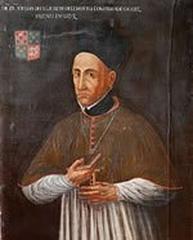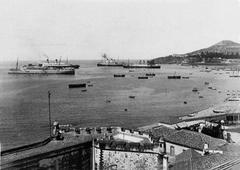Casa Da Alfândega Do Funchal: Visiting Hours, Tickets, and Comprehensive Guide to Funchal Historical Sites
Date: 04/07/2025
Introduction
Casa Da Alfândega Do Funchal, the historic Customs House, is a striking symbol of Madeira’s maritime heritage and architectural grandeur. Situated in the heart of Funchal, this landmark traces its origins to the late 15th century, when it became a pivotal site for regulating the island’s sugar trade and Atlantic commerce. Over the centuries, Casa Da Alfândega has evolved, blending Manueline, Mudejar, Renaissance, and Baroque architectural styles. Its enduring presence reflects Funchal’s transformation from a colonial trading post to a vibrant capital, making it a must-visit for history enthusiasts, architecture aficionados, and curious travelers alike. This guide offers a detailed overview of Casa Da Alfândega Do Funchal visiting hours, ticketing information, architectural highlights, accessibility, nearby attractions, and practical travel tips to help you make the most of your visit.
For the latest updates on visiting hours and events, consult the Madeira Tourism Official Website and the regional cultural portal (cultura.madeira.gov.pt).
Table of Contents
- Historical Background and Evolution
- Architectural Features and Artistic Heritage
- Cultural Significance and Community Role
- Location and Access
- Visiting Information: Hours, Tickets, and Accessibility
- Nearby Attractions and Travel Tips
- FAQs
- Visuals and Maps
- Conclusion and Call to Action
- References
Historical Background and Evolution
Early Foundations and Strategic Importance
Established in the late 15th century, Casa Da Alfândega Do Funchal was integral to Madeira’s emergence as a bustling Atlantic trading hub. Its primary function was to regulate goods arriving and departing from Funchal’s port—most notably sugar, which propelled the island’s economic boom during the Age of Discovery. The building served as both a customs checkpoint and a center for local administration and governance.
Architectural Evolution and Defensive Adaptations
Initially constructed in the ornate Manueline style, the customs house was subsequently fortified, especially after French corsair attacks in the 16th century. Defensive measures, including walls and a marine battery, were added in the 17th and 19th centuries to protect the vital commercial precinct. After the 1748 earthquake, Baroque-influenced repairs and expansions further enhanced the building’s structure while preserving its Renaissance essence (cultura.madeira.gov.pt).
Restoration and National Monument Status
Casa Da Alfândega was classified as a National Monument in 1943. Major restoration campaigns in the mid-20th century preserved its Manueline façades, uncovered original Mudejar-style ceilings, and adapted the building for contemporary use. From the 1980s onward, the customs house also became home to the Regional Legislative Assembly, blending heritage preservation with modern civic function (dnoticias.pt).
Architectural Features and Artistic Heritage
Renaissance and Manueline Foundations
Commissioned in the early 16th century under King Manuel I, Casa Da Alfândega showcases distinctive Manueline stonework, including intricately carved portals and window frames. Local basalt stone gives the building its characteristic appearance, while maritime motifs evoke Funchal’s seafaring legacy (cultura.madeira.gov.pt).
Defensive and Baroque Modifications
Fortifications and Baroque enhancements were made following security threats and natural disasters. The marine battery (1817) and Baroque-style chapel of Santo António da Mouraria (1714, restored in 1990) exemplify the building’s adaptive architecture.
Interior and Artistic Highlights
Visitors can admire well-preserved 17th and 18th-century wooden ceilings, period furnishings, decorative tilework, and notable sculptures such as the contemporary “Trilogia dos Poderes” by Amândio de Sousa, symbolizing the three branches of power (cultura.madeira.gov.pt). Key rooms, such as the Sala dos Contos (Accounts Room) and Sala do Despacho (Dispatch Room), offer further insight into Madeira’s administrative and artistic history.
Cultural Significance and Community Role
Casa Da Alfândega Do Funchal played a pivotal role in regulating Madeira’s lucrative sugar and wine trade, shaping the economic and social fabric of Funchal. Beyond its original fiscal function, the building is a protected National Monument and hosts exhibitions, civic ceremonies, and cultural events, underscoring its ongoing importance as a community hub (visitmadeira.com).
Location and Access
Casa Da Alfândega Do Funchal is located at Avenida do Mar e das Comunidades Madeirenses, 24, 9000-054 Funchal, parallel to the scenic waterfront and within walking distance of the Old Town and other major attractions. The site is easily accessible by public transport, with several bus stops and parking garages nearby. The cruise port is also just a short stroll away (municipiosefreguesias.pt, fullsuitcase.com).
Visiting Information: Hours, Tickets, and Accessibility
Visiting Hours
- Casa Da Alfândega Do Funchal (Administrative Offices):
Monday to Friday, 9:00 AM – 5:00 PM
Closed weekends and public holidays (tariffnumber.com). - Legislative Assembly Building (historic customs house):
Monday to Friday, 9:00 AM – 12:30 PM and 2:00 PM – 5:30 PM
Closed weekends and public holidays (cultura.madeira.gov.pt).
Note: Interior access may be limited due to government activities. Check in advance for special exhibitions or guided tours.
Tickets and Entry
- Exterior Viewing: Free, accessible year-round.
- Interior Access: Free during public events, guided tours, or special exhibitions. Contact the administration or check official channels for details.
Accessibility
The area around Casa Da Alfândega is generally accessible, with wide pavements and ramps. Some historic interiors may have uneven flooring or stairs; assistance is available upon request. Visitors with mobility needs should contact the site ahead of time to ensure comfort.
Guided Tours and Special Events
Casa Da Alfândega is often included in walking tours of Funchal’s Old Town. Guided tours of the interior may be available during special events. Advance booking is recommended (nomads-travel-guide.com).
Nearby Attractions and Travel Tips
- Rua dos Tanoeiros: Historic wine trade street.
- Funchal Waterfront (Avenida do Mar): Promenade for walks and Atlantic views.
- Zona Velha (Old Town): Restaurants, shops, and street art.
- Cathedral of Funchal: Manueline masterpiece nearby (fullsuitcase.com).
- Palácio de São Lourenço and Mercado dos Lavradores: Easily reached on foot (portobay.com).
Best Time to Visit: Spring and early summer (Madeira Flower Festival) or autumn for warm seas and fewer crowds.
Facilities: Cafés, shops, and restrooms are available nearby.
Safety: Funchal is safe, but remain mindful of belongings.
Photography: The building’s façade, portals, and nearby waterfront offer excellent photo opportunities, especially in soft morning or late afternoon light.
Frequently Asked Questions (FAQs)
Q: What are the Casa Da Alfândega Do Funchal visiting hours?
A: Administrative offices: Monday–Friday, 9:00 AM–5:00 PM; Legislative Assembly: Monday–Friday, 9:00 AM–12:30 PM and 2:00 PM–5:30 PM. Closed weekends and public holidays.
Q: Is there an admission fee or ticket?
A: No general admission fee for the exterior. Interior access is free during public events, guided tours, or exhibitions.
Q: Are guided tours available?
A: Yes, especially for groups or during special events. Booking in advance is advised.
Q: Is the site wheelchair accessible?
A: The general area is accessible; some interiors may have limitations.
Q: How do I get there?
A: By air (Cristiano Ronaldo International Airport), public transport (buses to city center), or car (parking garages nearby).
Visuals and Maps
- [Image: Casa da Alfândega facade overlooking Avenida do Mar, with historic stone architecture. Alt text: “Casa da Alfândega Funchal historic customs house building facade”]
- [Image: Map showing Casa da Alfândega’s location in Funchal’s historic center, highlighting nearby attractions. Alt text: “Map of Casa da Alfândega and surrounding Funchal historic sites”]
Conclusion
Casa Da Alfândega Do Funchal is an essential stop for anyone interested in Madeira’s maritime history, architectural legacy, and vibrant urban culture. Its imposing façade, unique blend of styles, and central location make it a highlight of Funchal’s historic center. Whether admiring its exterior, joining a guided tour, or discovering nearby landmarks, visitors gain a deeper appreciation of the city’s dynamic evolution.
For the latest Casa Da Alfândega Do Funchal visiting hours and ticket information, consult official resources. Enhance your experience with the Audiala app, which offers audio guides and curated maps, and stay connected to Madeira’s cultural events through our social channels.
Call to Action
Download the Audiala app for guided tours, maps, and insider tips on Funchal’s top historical attractions. Follow us on social media for event updates, travel ideas, and more ways to explore the best of Madeira!
References and External Links
- Madeira Tourism Official Website (https://www.visitmadeira.pt)
- Cultura Madeira - Old Building “Alfândega do Funchal” (https://cultura.madeira.gov.pt/en/looking-back/1081-old-building-%E2%80%9Calf%C3%A2ndega-do-funchal%E2%80%9D.html)
- DNotícias - Article on Alfândega do Funchal restoration (https://www.dnoticias.pt/2020/8/20/71291-veja-o-antes-e-o-depois-do-edificio-da-alfandega-do-funchal/)
- Visit Funchal Tourism Portal (https://visit.funchal.pt)
- The Country Jumper - Travel Guide to Funchal (https://thecountryjumper.com/things-to-know-before-visiting-funchal/)
- Nomads Travel Guide - Funchal City Guide (https://www.nomads-travel-guide.com/city/funchal-madeira-the-complete-guide/)
- Full Suitcase - Things to Do in Funchal (https://fullsuitcase.com/funchal-things-to-do/)
- Municipiosefreguesias.pt - Official Municipal Entity (https://www.municipiosefreguesias.pt/entidade/592654/alfandega-do-funchal)


